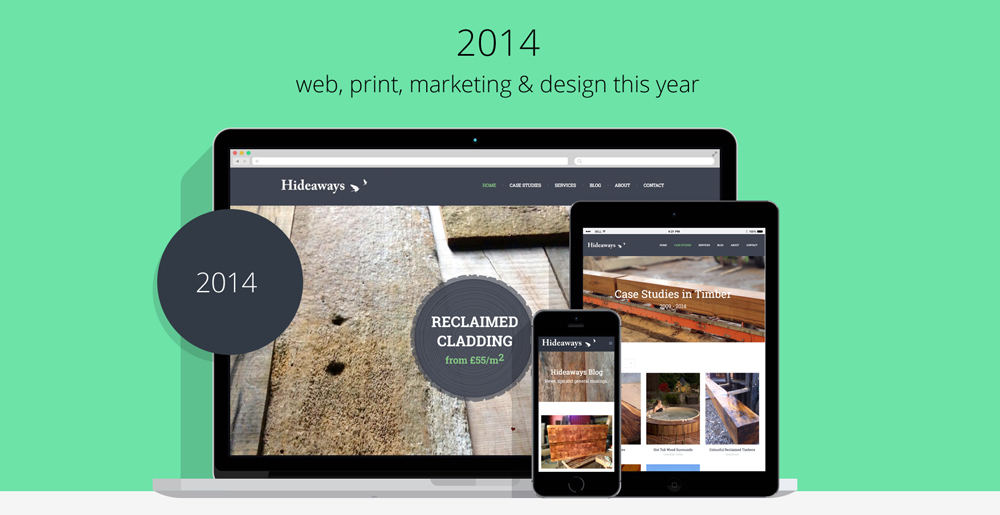What to watch out for this year
Here is a quick look at what web design, social and online marketing technologies and trends we’re likely to be talking about, testing and then implementing during 2014.
Full social media adoption is crucial
Even in 2013 it has been clear that having a social media strategy is now a requirement, but in 2014 the tipping point will occur where mass adoption over social media strategies is the norm and those who aren’t up to speed will be left behind. Companies who have already put a strategy in place are seeing the benefits of this with lead generation, referrals and revenue increasing as a result of their activity. 2014 will see these businesses employ dedicated social media publishers or outsource to social media companies. In a nutshell the benefits of social media are many, but they include: Improved social presence which is a factor for search engine results, increase in brand awareness, referrals and word or mouth advertising, a way to increase customer loyalty and also to increase your overall customer reach.
Responsive websites evolve
Responsive website design has been becoming more popular over the last year or so and particularly in the latter half of 2013 we are now seeing nearly all sites including the ability to respond to the device and change their formatting and content to suit the user. This will become another key requirement as mobile traffic overtakes desktop traffic for many sites over the course of next year. We will see a greater shift in not only changing the format of the site but actually serving more relevant content to the mobile user instead on the standard desktop site. This will include simpler and more concise messaging and less image heavy content.
Flat design for the style conscious
This is a design trend that will come to the fore in 2014 mainly due to the adoption of it by Windows and the new Apple iOs7 used on iPhones and iPads. Flat design is the use of flat colours and simple crisp distinct graphical icons and illustrations and sharp typography. The use of shadowing, gradients or layering effects is thrown out in favor of this more minimal and stylised look. This design trend also works well with mobile delivered content as the file sizes for flat graphics are up to 40% smaller than gradients and textures which makes loading times faster. It also helps to support the growing need to deliver content in simpler and snappier chunks that make for a more intuitive user experience.
Retina screen ready
The Apple produced Retina Displays have double the pixels in the same screen size as standard screens which make for a much crisper display, even to the point where you can not see the pixels with the naked eye. In 2014 we should see other manufactures using their own versions of this and therefore a need for designers to provide higher quality image to realise the potential of those screens. This new technology also works alongside flat design where photos are larger and have high definition but the graphical elements and shapes are simpler and crisper. Sites that are not optimised will look blurred and fuzzy on these new devices.
Google will aim to predict your next move
Google has been working on the move towards natural language search where they are making search more accurate and intuitive. Google are releasing intelligent personal assistants like Google Now and Apple also have Siri. The aim is to have information intelligently delivered to you and ideally before you have requested it. The change being implemented is to stop you from having to manully request information, and instead to have delivered to your device so it is ready when you need it. Natural language search will start to overtake keyword-based search and this was a key reason why Google updated with their largest algorithm update called Hummingbird earlier this year. If you haven’t already, download Google Now to your mobile device and experiment with it’s features.
2014 The Year of Google+
When Google+ first launched there was a lot of buzz which quickly fizzled away, now however it is steadily building into a force to be reckoned with. Facebook is still by some way the clear leader with 1.15 billion active users but Google+ is now in second place with 343 million regular users. Google plus is more that just a social network though, as you are connected to all Google’s other services. Google+ is an important cog in Google’s masterplan in terms of SEO and providing a more predictive search experience as discussed above. A key thing from a business perspective is the addition of Google Authorship, which we will seen as a fundamental aspect to determining search rankings in 2014. By adding your Google+ profile and authorship tag to your blog posts you authenticate them as original and increase not only your websites authority but also your individual social influence and reach. As Google+ provides further integration with other services and web data I predict it will continue to gain on Facebook and provide more value in term of the users daily information and social interaction needs.
If you have a chance in the early New Year to review these and other emerging trends it will help put you in good shape for another year of fast paced technology advances, all of which we be discussing here.





